Sunday morning in Seattle, people should be drinking their morning coffee, reading a paper (or this site, obviously) or going for a morning run. But when the Seahawks are headed for the Super Bowl, the city takes on a different vibe. Streets are lined with people along the drive from the team’s offices and training facility at the Virginia Mason Athletic Center (VMAC) in Renton, to SeaTac for their journey to Phoenix.
The airport was surrounded by fans, family, and friends of airport staff who were plane-side to wave farewell. But their departure leads to a bigger, more important, question for AvGeeks: who, and what, were they flying?
The Seahawks were stepping off of their buses directly onto the ramp at SeaTac, taking a short few steps to the aircraft, a Delta 767-400ER. That’s right, I said Delta, not Alaska. So many of you are scratching your head and thinking, “Umm why are they not flying the hometown airline (Alaska) to Phoenix?” Well, there are many factors at play here, but it all seems to form another part of the “Battle in Seattle” between Delta and Alaska.
There are multiple parts to a sports team and airlines: who they fly on (aka the charter contract) and who sponsors them (aka the sponsorship deals).
Before we delve into the sponsorship deals, let’s take a quick look at why they were flying Delta that morning. The easy answer is going to be aircraft size. I come from Australia, where professional football teams all fly commercial. Why? Because the actual team, plus staff is only about 20 or 30 people. That doesn’t justify a one-to-two-hour flight on a charter aircraft, costing quite a lot of money.
An NFL team, on the other hand, has an enforced limit of 53 people on the roster. That is just players – time to add on coaching staff, managers, press, medical staff, all sorts of other important people, and that ends up coming to about four bus loads of people (at least that is what the Seahawks rolled up with). Some of those players are not exactly small, either, so they need their space, and the team travels with a lot of equipment.
A charter aircraft in the size range of an A330 or Boeing 767 makes sense. You have the range to make a cross-country trip non-stop, plenty of space onboard for the players to fit comfortably, and the payload to take every single thing they need. Alaska just can’t compete with an airline like Delta in that kind of charter market.
Because of their available aircraft and competitive pricing, Delta ends up flying nearly half of current NFL teams. The Seahawks flying on them has nothing to do with hometown allegiance, but more to do with costs, fleet, and utilization.
That same 767 that flew the Seahawks was flying revenue services the day before, and once it finished dropping off in Phoenix it flew off to Boston to pick up the Patriots. It is all about business.
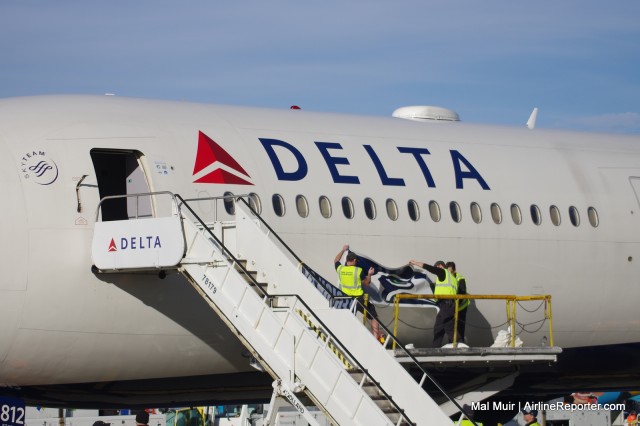
A special Seahawks sticker was emblazoned on the aircraft just for the departure event. It was not flight-rated.
This doesn’t mean there still isn’t a “Battle in Seattle” between Delta and Alaska on the football front as well. Even though Delta has the contract to fly the team around the country, that wouldn’t just make them the ’œOfficial Airline of the Seahawks.’ They happen to also hold sponsorship rights to that title, taking it away from Alaska, who held that title just a few years ago.
The Seahawks aren’t the only big name team that they sponsor, with the likes of Chelsea FC (that’s an English soccer team in case you are thinking ’œwho the hell are they?’) and the New York Yankees. So, sponsoring a team in a city that they are trying to grow in is smart, right? Well, if you have one team (the Seahawks), why not make it a double and take on the soccer team as well. That’s right, Delta also sponsors the Seattle Sounders (the MLS team).
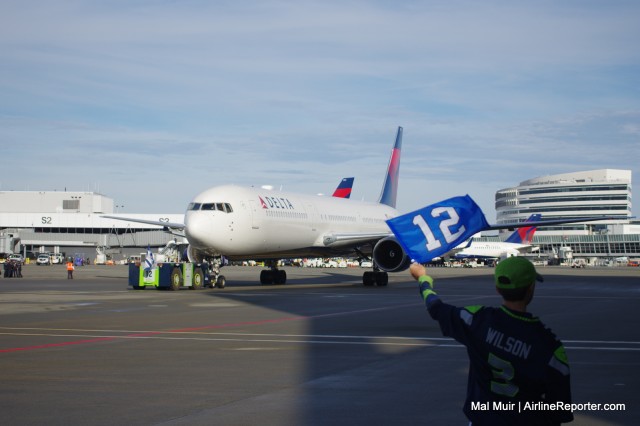
This Seahawks fan may be waving goodbye to a Delta flight, but can get priority boarding on Alaska just by wearing his Wilson jersey
One thing Delta will not do is sponsor individuals, something Alaska Airlines has no qualms with, apparently. Alaska decided to sponsor Seahawks quarterback Russell Wilson and term him the airline’s ’œChief Football Officer.’ But in no marketing can they mention the team he plays for. All of which can be quite confusing when if you are wearing a Russell Wilson Seahawks jersey and going to board an Alaska Airlines flight, where you can get priority boarding.
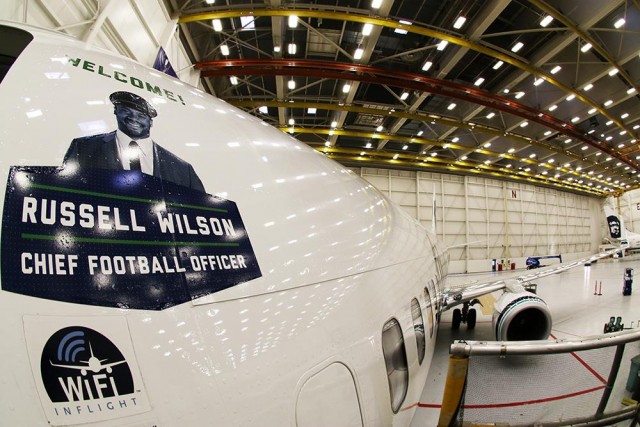
Alaska Airlines sponsors Russell Wilson as their Chief Football Officer and even has a 737-900ER specially painted, just for him – Photo: Alaska Airlines
So here we have one airline who sponsors the full team, yet another competing airline which sponsors just a single player. At no time is anyone breaking any contracts because the team is the one contracted in the sponsorship deal, not the player themselves. So close to being dodgy, yet seemingly legal. I really bet someone in the Delta office is kicking themselves for not signing a contract with some of the players earlier.
This is really just another part of the whole ’œBattle in Seattle’. Both Delta and Alaska saw great years in 2014 and this year will hopefully be just as good, if not better, for them. Seattle has seen bumper growth as well, so this whole battle has really meant that the true winner in this fight is not the airlines, but the passengers. No matter who keeps throwing out the better sales, new destinations, or frequent flyer incentives, the flying public is the true winner here.
Comments are closed here.
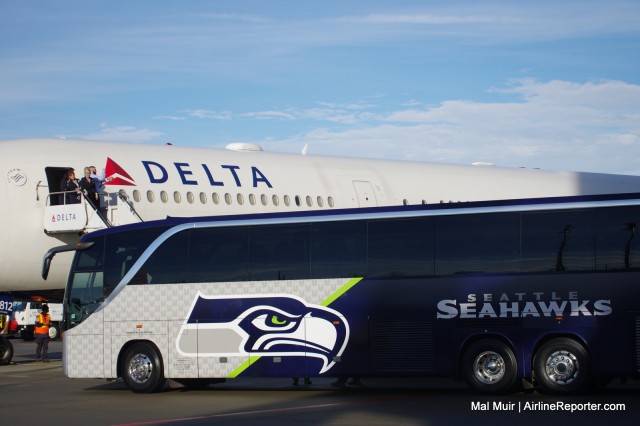
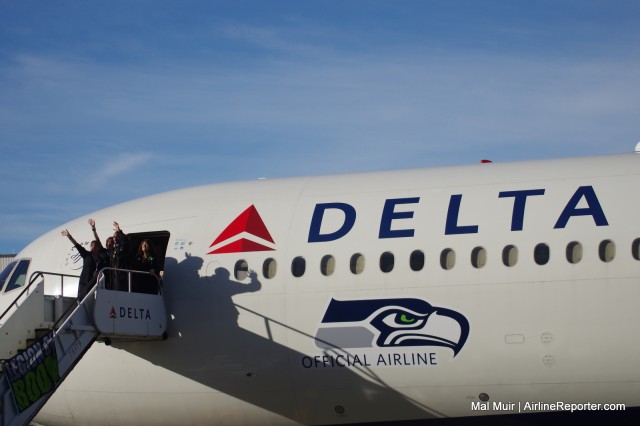
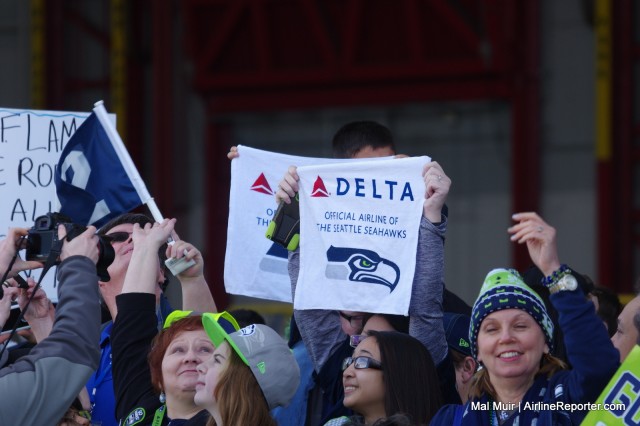
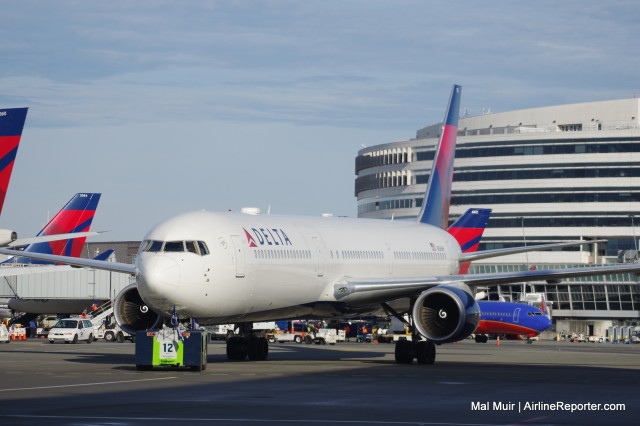
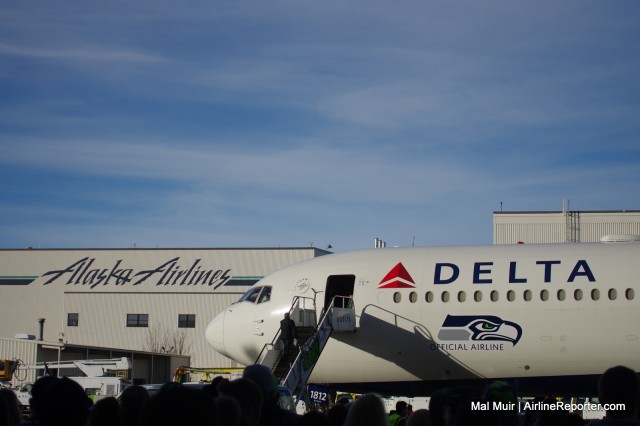
For the Cotton Bowl as well as the national football championship, Delta flew the Michigan State and Ohio State contingent to DFW on a chartered B744. . . quite a rare sight into this airport.
Thanks for a well written, unbiased analysis. I read a similar piece by Steve Wilhelm in the Puget Sound Business Journal, and after reading it, I thought he was on Alaska’s payroll.
Alaska is a fine airline, but your piece hits on the reasons why the ‘Hawks made the obvious choice.
Wonder if any of the Seahawks wrote messages on the backs of tray tables or napkins and left them for the Patriots…